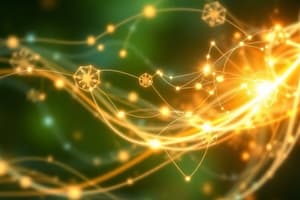Podcast
Questions and Answers
What is the main function of the Renal/Urinary system?
What is the main function of the Renal/Urinary system?
- Transportation of oxygen, nutrients and hormones throughout the body
- Draining of excess tissue fluid and immune defense of the body
- Production of reproductive cells
- Filtration of blood and eliminating unnecessary compounds and waste by producing and excreting urine (correct)
Which body system is responsible for the transportation of oxygen, nutrients, and hormones throughout the body?
Which body system is responsible for the transportation of oxygen, nutrients, and hormones throughout the body?
- Reproductive system
- Circulatory/Cardiovascular system (correct)
- Integumentary system
- Endocrine system
What is the primary purpose of the Digestive system?
What is the primary purpose of the Digestive system?
- Physical protection of the body surface
- Mechanical and chemical degradation of food for absorption into the body (correct)
- Production of hormones to regulate bodily functions
- Initiation and regulation of vital body functions
Which system is responsible for the initiation and regulation of vital body functions, sensation, and body movements?
Which system is responsible for the initiation and regulation of vital body functions, sensation, and body movements?
What does the Integumentary system primarily provide to the body?
What does the Integumentary system primarily provide to the body?
Which system is involved in the production of hormones to regulate a wide variety of bodily functions?
Which system is involved in the production of hormones to regulate a wide variety of bodily functions?
Which body system works as a support structure for the body, gives the body its shape, makes blood cells, provides protection for organs, and stores minerals?
Which body system works as a support structure for the body, gives the body its shape, makes blood cells, provides protection for organs, and stores minerals?
Which cell type is associated with the circulatory system?
Which cell type is associated with the circulatory system?
Which of the following organisms is an autotroph?
Which of the following organisms is an autotroph?
Which bone is involved in holding, walking, swimming, and flying?
Which bone is involved in holding, walking, swimming, and flying?
What type of reproduction involves meiosis?
What type of reproduction involves meiosis?
Which organ is responsible for regulation in the body?
Which organ is responsible for regulation in the body?
What adaptation helps an organism to hang onto whatever they are climbing?
What adaptation helps an organism to hang onto whatever they are climbing?
Which organism has webbed feet to help them swim and look for food?
Which organism has webbed feet to help them swim and look for food?
Which organism has big eyes to help them see at night while they hunt?
Which organism has big eyes to help them see at night while they hunt?
What type of reproduction involves stolon?
What type of reproduction involves stolon?
Flashcards are hidden until you start studying
Study Notes
Body Systems
- The Renal/Urinary system filters waste and excess fluids from the blood, regulating electrolyte levels and maintaining acid-base balance.
- The Circulatory system transports oxygen, nutrients, and hormones throughout the body.
- The Digestive system breaks down ingested food into nutrients for energy, growth, and repair.
- The Nervous system initiates and regulates vital body functions, sensation, and body movements.
- The Integumentary system provides a protective barrier, regulates body temperature, and aids in the senses of touch and feel.
- The Endocrine system produces hormones to regulate a wide variety of bodily functions, including growth, metabolism, and reproductive processes.
Skeletal System
- The Skeletal system serves as a support structure for the body, gives the body its shape, produces blood cells, provides protection for organs, and stores minerals.
Cell Types
- Red blood cells are associated with the Circulatory system.
Organisms
- Autotrophs are organisms that produce their own food through photosynthesis or chemosynthesis.
- Birds have the pelvis bone, which is involved in holding, walking, swimming, and flying.
Reproduction
- Sexual reproduction involves meiosis, the process of gamete formation.
- Asexual reproduction involves stolon, a type of vegetative propagation.
Adaptations
- Clinging adaptations, such as claws or tendrils, help organisms hang onto whatever they are climbing.
- Webbed feet are an adaptation that helps organisms swim and search for food, found in ducks and other aquatic birds.
- Large eyes are an adaptation that helps organisms see at night while they hunt, found in nocturnal animals such as owls.
Regulation
- The brain is responsible for regulation in the body, controlling various functions such as movement, sensation, and cognition.
Studying That Suits You
Use AI to generate personalized quizzes and flashcards to suit your learning preferences.




